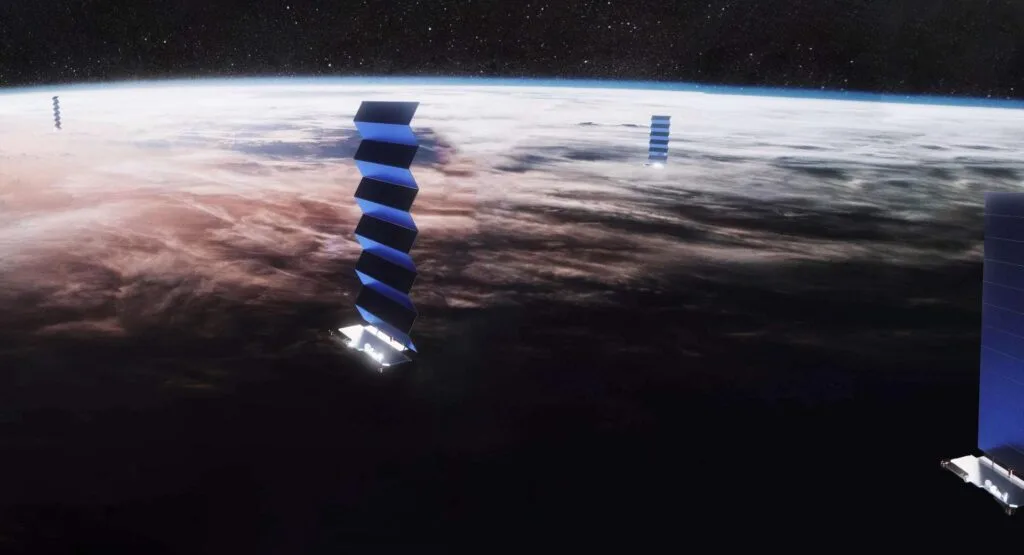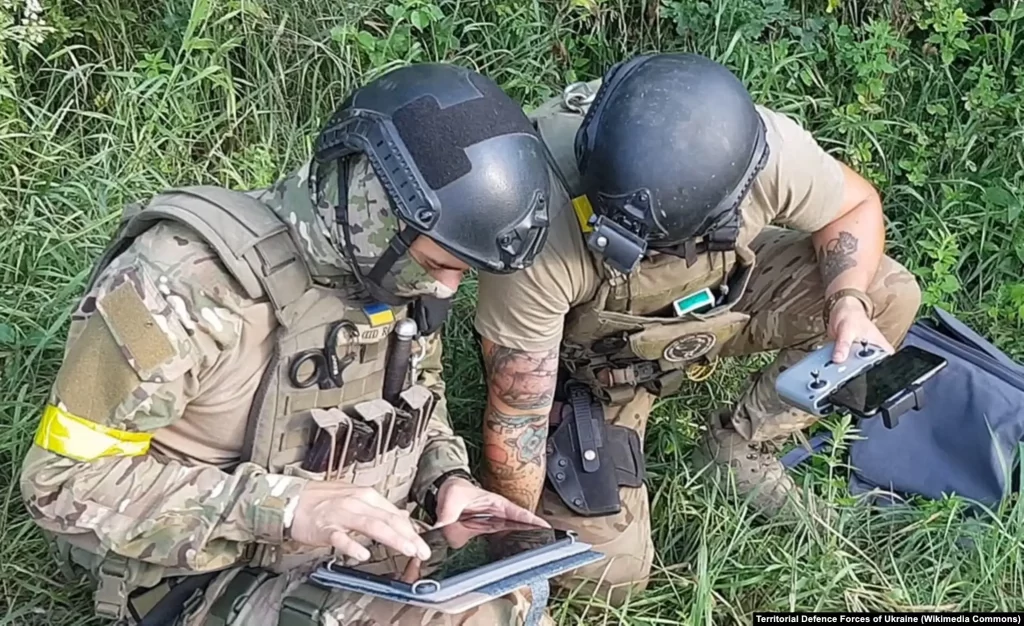Governments had always the control over providing technologies during warfare. Everything changed when the Ukraine-Russia war broke out.
How does Starlink Work?
According to Ukraine website, the Starlink system can provide access to high-speed Internet in remote locations without the need for cable wirings or a lot of infrastructure. Since Starlink’s system satellites are in low Earth orbit, there is not much signal delay- only up to 20 milliseconds, unlike its closest competitors.
Currently, the architecture of the Starlink system consists of three main components: a grouping of satellites in low orbits, a network of ground stations, and user terminals.

Starkink satellites as imagined by an artist. Source: SpaceX
Gateway stations are installed on the ground in order for the Internet to work. The gateway station then connects to the satellite, which, in turn, transmits its signal to the terminal dish. To connect to the network, you need a terminal that looks like a small satellite dish, a tripod and a router.
Featured Image Source: Vernon, Utah Starlink Gateway / diadumenianus via Reddit

Tilting the Odds of the War
In 2021, Elon Musk’s SpaceX, a private company, delivered Starlink terminals to Ukraine’s army. This made it possible to provide the Ukrainian government and the armed forces with stable connection, which became one of the reasons for the failure of the Russian plans.
With Starlink’s network of more than 2,000 satellites orbiting the Earth in communication with thousands of terminals on the ground, Ukraine’s activation not only restored communications across Ukraine but also proved invaluable on the combat front.
This allowed Kyiv’s troops to stay connected to each other despite the bombing of terrestrial telecommunication networks. The Starlink system helped maintain the cohesion of Ukrainian President Volodymyr Zelensky’s army and allowed his command to continue operations. “Starlink technologies have changed this war,” Mr. Fedorov acknowledged at a conference in Lisbon in early November. It’s a decisive contribution that has not escaped the attention of Western armies.

“Moscow’s forces are attempting to obstruct Internet connectivity from space by using jammers. However, according to SpaceX, a software upgrade has been released for Starlink that can avoid jamming transmitters and save power usage.”, Radio Free Library said.
Private Companies in War Efforts
Russia’s full-scale invasion of Ukraine led to the fact that SpaceX suddenly found itself in the position of a global player capable of exerting a decisive influence on the course of hostilities. Yet questions remain about how committed its billionaire owner is to supporting the war effort and his unpredictable character.
SpaceX also isn’t the the only private company that came to Ukraine’s aid. Shortly after the start of the invasion, Ukrainian entrepreneur Max Polyakov formed a real “coalition” consisting of aerospace companies that have satellites designed to photograph the Earth’s surface. Their images are quickly transmitted to the Armed Forces, allowing them to track the movement of Russian troops and plan combat operations.
Are we seeing a turnover of highly political war aid to private companies? How will warfare look like when countries/groups will seek private companies instead of leveraging political decks with governments and international rights agencies?
Starlink in the Philippines
The DICT met with SpaceX officials in November of 2021 to discuss the possibility of Starlink Philippines – a Philippine-registered company that will be a wholly-owned subsidiary of SpaceX.
However, Information Assistant Secretary Philip Varilla told reporters last year that the December schedule of Starlink’s entry in the Philippine market was moved to first semester of 2023, according to Elijah Rosales of Philippine Star.
SpaceX offers its equipment at USD 599 or Php 33,482 per unit – a hefty sum, especially for people in remote areas.
Meanwhile, its internet connectivity service is pegged at USD 99 or Php 5,535 monthly – not a cheap price either.
The DICT assured that the government would shoulder the costs for connecting residents of remote areas to Starlink. These communities would then be monitored until such time that their collective income goes up and the expenses can be passed on to them.
Yugatech, the Philippines’ largest and oldest tech site, also shared pricing schemes shared by one of the site’s readers.
These prices aren’t the same as those with the government’s deal with SpaceX but are intended for businesses and shipping lines. These prices are of course not yet final, but worth checking out.
Starlink Enterprise KIT
Php 176,176 (starter kit plus taxes)
Php 3,824 (Data Lake and local handling fees)
Php 21,600 (VAT)
TOTAL: Php 201,600
Starlink Maritime KIT
Php 644,376.99 (starter kit plus taxes)
Php 5,624 (Data Lake and local handling fees)
Php 78,000 (VAT)
TOTAL: Php 728,000#



























